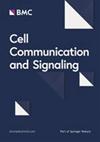调节电压门控钠通道,促进分化并使胶质母细胞瘤细胞对化疗敏感
IF 8.2
2区 生物学
Q1 CELL BIOLOGY
引用次数: 0
摘要
胶质母细胞瘤(GBM)是成人胶质瘤中发病率最高、侵袭性最强的一种。尽管采取了包括手术、放疗和化疗在内的强化治疗方法,但胶质母细胞瘤干细胞仍会导致肿瘤复发和预后不良。通过操纵转录机制诱导胶质母细胞瘤干细胞分化已成为治疗胶质母细胞瘤的一种有前途的策略。在这里,我们探索了一种创新方法,研究了在患者衍生的胶质母细胞瘤球形细胞(GSCs)中观察到的去极化静息膜电位(RMP)的作用,这种作用使它们能够在细胞周期的G0期保持干性特征。我们在体外和体内进行了分子生物学和电生理学实验,研究电压门控钠通道(Nav)在GSCs中的功能表达,尤其关注其依赖细胞周期的功能表达。研究人员对Nav的活性进行了药理调控,并通过活体成像细胞周期分析、自我更新实验和化学敏感性实验评估了Nav对GSCs行为的影响。我们通过体外通路分析和体内肿瘤增殖试验,研究了 Nav 在调控 GBM 干性中的作用机制。我们证明,Nav主要在细胞周期的G0期被GSCs功能性表达,这表明它在调节RMP中起着关键作用。通过诱导细胞周期从 G0 期重新进入 G1/S 过渡期,药物阻断 Nav 使 GBM 细胞更易受替莫唑胺(TMZ)的影响,而替莫唑胺是治疗这类肿瘤的标准药物。此外,抑制 Nav 能显著影响 GSCs 的自我更新和多能特征,同时提高它们的分化程度。最后,我们的数据表明,Nav通过使RMP去极化和抑制ERK信号通路来积极调节GBM干性。值得注意的是,体内增殖评估证实,药物阻断Nav后,患者对TMZ的敏感性增加。这一观点将Nav定位为一种有前景的预后生物标志物和GBM患者的治疗靶点,尤其是与替莫唑胺治疗结合使用时。本文章由计算机程序翻译,如有差异,请以英文原文为准。
Modulating voltage-gated sodium channels to enhance differentiation and sensitize glioblastoma cells to chemotherapy
Glioblastoma (GBM) stands as the most prevalent and aggressive form of adult gliomas. Despite the implementation of intensive therapeutic approaches involving surgery, radiation, and chemotherapy, Glioblastoma Stem Cells contribute to tumor recurrence and poor prognosis. The induction of Glioblastoma Stem Cells differentiation by manipulating the transcriptional machinery has emerged as a promising strategy for GBM treatment. Here, we explored an innovative approach by investigating the role of the depolarized resting membrane potential (RMP) observed in patient-derived GBM sphereforming cell (GSCs), which allows them to maintain a stemness profile when they reside in the G0 phase of the cell cycle. We conducted molecular biology and electrophysiological experiments, both in vitro and in vivo, to examine the functional expression of the voltage-gated sodium channel (Nav) in GSCs, particularly focusing on its cell cycle-dependent functional expression. Nav activity was pharmacologically manipulated, and its effects on GSCs behavior were assessed by live imaging cell cycle analysis, self-renewal assays, and chemosensitivity assays. Mechanistic insights into the role of Nav in regulating GBM stemness were investigated through pathway analysis in vitro and through tumor proliferation assay in vivo. We demonstrated that Nav is functionally expressed by GSCs mainly during the G0 phase of the cell cycle, suggesting its pivotal role in modulating the RMP. The pharmacological blockade of Nav made GBM cells more susceptible to temozolomide (TMZ), a standard drug for this type of tumor, by inducing cell cycle re-entry from G0 phase to G1/S transition. Additionally, inhibition of Nav substantially influenced the self-renewal and multipotency features of GSCs, concomitantly enhancing their degree of differentiation. Finally, our data suggested that Nav positively regulates GBM stemness by depolarizing the RMP and suppressing the ERK signaling pathway. Of note, in vivo proliferation assessment confirmed the increased susceptibility to TMZ following pharmacological blockade of Nav. This insight positions Nav as a promising prognostic biomarker and therapeutic target for GBM patients, particularly in conjunction with temozolomide treatment.
求助全文
通过发布文献求助,成功后即可免费获取论文全文。
去求助
来源期刊

Cell Communication and Signaling
CELL BIOLOGY-
CiteScore
11.00
自引率
0.00%
发文量
180
期刊介绍:
Cell Communication and Signaling (CCS) is a peer-reviewed, open-access scientific journal that focuses on cellular signaling pathways in both normal and pathological conditions. It publishes original research, reviews, and commentaries, welcoming studies that utilize molecular, morphological, biochemical, structural, and cell biology approaches. CCS also encourages interdisciplinary work and innovative models, including in silico, in vitro, and in vivo approaches, to facilitate investigations of cell signaling pathways, networks, and behavior.
Starting from January 2019, CCS is proud to announce its affiliation with the International Cell Death Society. The journal now encourages submissions covering all aspects of cell death, including apoptotic and non-apoptotic mechanisms, cell death in model systems, autophagy, clearance of dying cells, and the immunological and pathological consequences of dying cells in the tissue microenvironment.
 求助内容:
求助内容: 应助结果提醒方式:
应助结果提醒方式:


